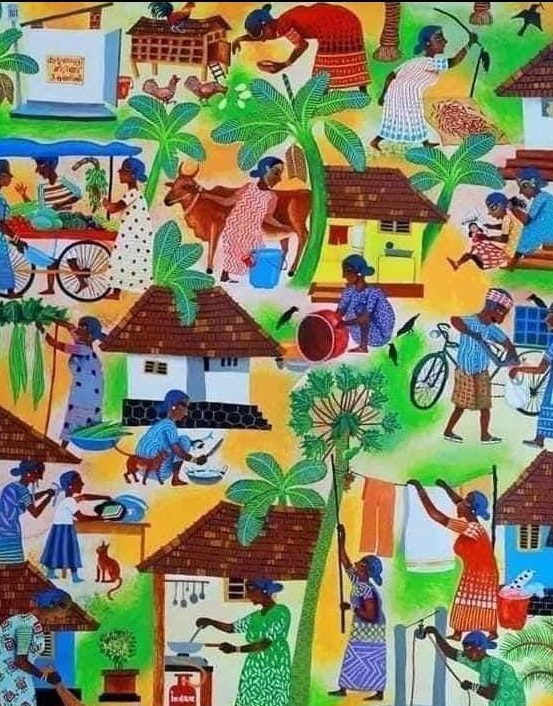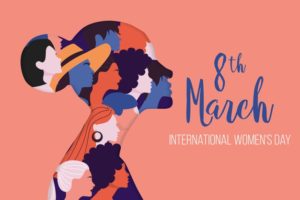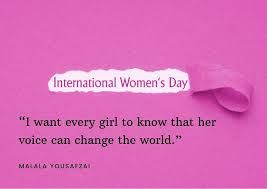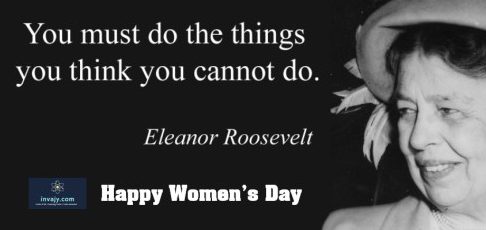
A student in grade 8 in one of the public schools in India created this drawing in response to his father who claimed his wife does not work. The drawing contains all the tasks his mother performs while she is “not working”. It became the cover poster for the Indian government’s 2021 report on gender equality. It was sent to me by my niece in honor of International Women’s Day, which is celebrated all over the world on March 8
th. I was taken aback, since I did not remember this celebration. When I grew up, and even when my children were growing up, I knew only Mother’s Day. We were encouraged to recite or sing poems telling mother how dear she is to us; how much we love and appreciate her. This was the day when my children used to make me breakfast in bed, and depending on their age sometimes my husband would pitch in and make coffee. When the kids were old enough there were pancakes as well, which I much preferred not to eat in bed. Oh, another thing: it was and is always on a Sunday. In most countries Mother’s Day is celebrated on the second Sunday in May, among them the USA, Canada, most European countries, Australia, New Zealand, India, China, Japan, the Philippines, and South Africa.

In Israel where I grew up. Sunday is a regular work day, so Mother’s Day is celebrated on the 30
th of Shevat, which occurs on different days every year according to the Gregorian calendar. However, for the past few years it evolved into Family Day instead of Mother’s Day. Growing up in the early days of the state of Israel, we could not afford restaurants, extravagant presents or taking the day off work, so what I remember doing is offering to take some of the burdens off my mother. I remember one time when I was 10 years old, I got up very early and took the keys to the municipal offices and cleaned there instead of my mother. I came home just as she was getting up, and gave her the keys, saying “Happy Mother’s Day – you can sleep in, I cleaned already.” Slowly, over the years, the population became more affluent, and people started to imitate the American way of celebrating the day. Going out to restaurants, elaborate gifts, and of course, flowers. The florists always flourish on any holiday celebration.

Wikipedia tells me that celebrating Mother’s Day started in 1908, when Anna Jarvis commemorated her mother, Ann Maria Reeves Jarvis who was a social activist and community organizer during the American Civil War era and was dedicated to peace. When it was first introduced for a vote, the Congress rejected the idea. One congressman commented: “next we will have to have a Mother-in-Law Day.” I guess the love of mothers-in-law was already well established. However, in 1914, Woodrow Wilson signed a proclamation designating Mother’s Day, held on the second Sunday in May, as a national holiday to honor mothers. So why do we need another holiday celebrating women?

The concept of International Women’s Day started during a time of great unrest, amid debates against oppression and inequality of workers. In 1908, 15,000 women marched through New York City demanding shorter hours, better pay, and voting rights. The next year, the Socialist Party of America observed the first National Women’s Day across the United States on February 28, 1909. Then, in 1910, the second International Conference of Working Women was held in Copenhagen, where Clara Zetkin, who led the Women’s Office for the Social Democratic Party in Germany, tabled the idea of an International Women’s Day. The idea was that every country would dedicate the same day to recognize women’s rights to equality. Over 100 women from 17 countries, representing unions, socialist parties, and working women’s clubs accepted the proposal unanimously. On March 9, 1911, International Women’s Day was honored for the first time in Austria, Denmark, Germany and Switzerland. More than one million women and men attended the rallies campaigning for women’s rights to work, vote, receive job training, and to hold public office, and against discrimination.

A terrible tragedy happened a week later in the Triangle Shirtwaist Factory in New York City. More than 140 women and girls died as a fire burned down the place. Most of the workers were Italian and Jewish immigrants. The fire drew significant attention to the working conditions and labor legislation in the country. The following March a big demonstration marked international Women’s Day focusing on women’s working conditions and human rights. Meanwhile in Russia, on the eve of World War I, women observed their first International Women’s Day on February 23, the last Sunday in February, with a strike for “bread and peace” to protest the death of over two million Russian soldiers. While it was February 23 on the Julian calendar used then in Russia, according to the Gregorian calendar, it was March 8. Since then, it was established as the date for International Women’s Day, a day to protest and demand for equal rights. It took the United Nations until 1975 to recognize the day, and in December 1977, the General Assembly adopted a resolution proclaiming the United Nations Day for Women’s Rights and International Peace to be observed on any day of the year by Member States in accordance with their historical and national traditions. As usual, a vague and watered-down declaration in order to please everyone, and affect no one.

March the 8
th is now International Women’s Day all over the world, however, as before, there is a big difference in the way it is celebrated. In Russia, it has been a civic holiday ever since its establishment. Everyone gets off work, and it is celebrated with parades honoring working women. Songs and dances are taught in kindergartens and schools, flowers are traditionally brought to women by their spouses, and families go on outings to celebrate. I learned all this from a friend whom I befriended at the pool here in Karmiel. She was puzzled why it is not a civic holiday here. The massive immigration from Russia to Israel created cultural changes, so now slowly International Women’s Day overshadows Mother’s Day. Once again, the florists flourish. After all, which woman does not love receiving flowers? And it is another opportunity for the perfume and beauty-product industry to push sales of items which they advertise as stuff that every women desires.
How do I as a woman want to be celebrated? I guess there are private and public needs, which may not be the same. As a private person, I want to be connected and respected by my family members for being a woman, a mother, a mother-in-law, who contributes emotionally, physically, and joyfully to the family. As a public person, I want to make sure women have freedom to pursue their education, profession, and aspirations in a society that promotes equality and protects from harm. So I think there is a place to celebrate both Mother’s Day and International Women’s Day, one as a private, family celebration and the other as a national and international way of uniting to celebrate our achievements and fight for more freedom and equality. We need to concentrate on changing the cultural attitudes towards the role of women in society. Change comes from challenge. The theme for this year’s International Women’s Day is #ChooseToChallenge, indicating that a “challenged world is an alert world, and from challenge comes change”.






 A student in grade 8 in one of the public schools in India created this drawing in response to his father who claimed his wife does not work. The drawing contains all the tasks his mother performs while she is “not working”. It became the cover poster for the Indian government’s 2021 report on gender equality. It was sent to me by my niece in honor of International Women’s Day, which is celebrated all over the world on March 8th. I was taken aback, since I did not remember this celebration. When I grew up, and even when my children were growing up, I knew only Mother’s Day. We were encouraged to recite or sing poems telling mother how dear she is to us; how much we love and appreciate her. This was the day when my children used to make me breakfast in bed, and depending on their age sometimes my husband would pitch in and make coffee. When the kids were old enough there were pancakes as well, which I much preferred not to eat in bed. Oh, another thing: it was and is always on a Sunday. In most countries Mother’s Day is celebrated on the second Sunday in May, among them the USA, Canada, most European countries, Australia, New Zealand, India, China, Japan, the Philippines, and South Africa.
A student in grade 8 in one of the public schools in India created this drawing in response to his father who claimed his wife does not work. The drawing contains all the tasks his mother performs while she is “not working”. It became the cover poster for the Indian government’s 2021 report on gender equality. It was sent to me by my niece in honor of International Women’s Day, which is celebrated all over the world on March 8th. I was taken aback, since I did not remember this celebration. When I grew up, and even when my children were growing up, I knew only Mother’s Day. We were encouraged to recite or sing poems telling mother how dear she is to us; how much we love and appreciate her. This was the day when my children used to make me breakfast in bed, and depending on their age sometimes my husband would pitch in and make coffee. When the kids were old enough there were pancakes as well, which I much preferred not to eat in bed. Oh, another thing: it was and is always on a Sunday. In most countries Mother’s Day is celebrated on the second Sunday in May, among them the USA, Canada, most European countries, Australia, New Zealand, India, China, Japan, the Philippines, and South Africa. In Israel where I grew up. Sunday is a regular work day, so Mother’s Day is celebrated on the 30th of Shevat, which occurs on different days every year according to the Gregorian calendar. However, for the past few years it evolved into Family Day instead of Mother’s Day. Growing up in the early days of the state of Israel, we could not afford restaurants, extravagant presents or taking the day off work, so what I remember doing is offering to take some of the burdens off my mother. I remember one time when I was 10 years old, I got up very early and took the keys to the municipal offices and cleaned there instead of my mother. I came home just as she was getting up, and gave her the keys, saying “Happy Mother’s Day – you can sleep in, I cleaned already.” Slowly, over the years, the population became more affluent, and people started to imitate the American way of celebrating the day. Going out to restaurants, elaborate gifts, and of course, flowers. The florists always flourish on any holiday celebration.
In Israel where I grew up. Sunday is a regular work day, so Mother’s Day is celebrated on the 30th of Shevat, which occurs on different days every year according to the Gregorian calendar. However, for the past few years it evolved into Family Day instead of Mother’s Day. Growing up in the early days of the state of Israel, we could not afford restaurants, extravagant presents or taking the day off work, so what I remember doing is offering to take some of the burdens off my mother. I remember one time when I was 10 years old, I got up very early and took the keys to the municipal offices and cleaned there instead of my mother. I came home just as she was getting up, and gave her the keys, saying “Happy Mother’s Day – you can sleep in, I cleaned already.” Slowly, over the years, the population became more affluent, and people started to imitate the American way of celebrating the day. Going out to restaurants, elaborate gifts, and of course, flowers. The florists always flourish on any holiday celebration. Wikipedia tells me that celebrating Mother’s Day started in 1908, when Anna Jarvis commemorated her mother, Ann Maria Reeves Jarvis who was a social activist and community organizer during the American Civil War era and was dedicated to peace. When it was first introduced for a vote, the Congress rejected the idea. One congressman commented: “next we will have to have a Mother-in-Law Day.” I guess the love of mothers-in-law was already well established. However, in 1914, Woodrow Wilson signed a proclamation designating Mother’s Day, held on the second Sunday in May, as a national holiday to honor mothers. So why do we need another holiday celebrating women?
Wikipedia tells me that celebrating Mother’s Day started in 1908, when Anna Jarvis commemorated her mother, Ann Maria Reeves Jarvis who was a social activist and community organizer during the American Civil War era and was dedicated to peace. When it was first introduced for a vote, the Congress rejected the idea. One congressman commented: “next we will have to have a Mother-in-Law Day.” I guess the love of mothers-in-law was already well established. However, in 1914, Woodrow Wilson signed a proclamation designating Mother’s Day, held on the second Sunday in May, as a national holiday to honor mothers. So why do we need another holiday celebrating women? The concept of International Women’s Day started during a time of great unrest, amid debates against oppression and inequality of workers. In 1908, 15,000 women marched through New York City demanding shorter hours, better pay, and voting rights. The next year, the Socialist Party of America observed the first National Women’s Day across the United States on February 28, 1909. Then, in 1910, the second International Conference of Working Women was held in Copenhagen, where Clara Zetkin, who led the Women’s Office for the Social Democratic Party in Germany, tabled the idea of an International Women’s Day. The idea was that every country would dedicate the same day to recognize women’s rights to equality. Over 100 women from 17 countries, representing unions, socialist parties, and working women’s clubs accepted the proposal unanimously. On March 9, 1911, International Women’s Day was honored for the first time in Austria, Denmark, Germany and Switzerland. More than one million women and men attended the rallies campaigning for women’s rights to work, vote, receive job training, and to hold public office, and against discrimination.
The concept of International Women’s Day started during a time of great unrest, amid debates against oppression and inequality of workers. In 1908, 15,000 women marched through New York City demanding shorter hours, better pay, and voting rights. The next year, the Socialist Party of America observed the first National Women’s Day across the United States on February 28, 1909. Then, in 1910, the second International Conference of Working Women was held in Copenhagen, where Clara Zetkin, who led the Women’s Office for the Social Democratic Party in Germany, tabled the idea of an International Women’s Day. The idea was that every country would dedicate the same day to recognize women’s rights to equality. Over 100 women from 17 countries, representing unions, socialist parties, and working women’s clubs accepted the proposal unanimously. On March 9, 1911, International Women’s Day was honored for the first time in Austria, Denmark, Germany and Switzerland. More than one million women and men attended the rallies campaigning for women’s rights to work, vote, receive job training, and to hold public office, and against discrimination. A terrible tragedy happened a week later in the Triangle Shirtwaist Factory in New York City. More than 140 women and girls died as a fire burned down the place. Most of the workers were Italian and Jewish immigrants. The fire drew significant attention to the working conditions and labor legislation in the country. The following March a big demonstration marked international Women’s Day focusing on women’s working conditions and human rights. Meanwhile in Russia, on the eve of World War I, women observed their first International Women’s Day on February 23, the last Sunday in February, with a strike for “bread and peace” to protest the death of over two million Russian soldiers. While it was February 23 on the Julian calendar used then in Russia, according to the Gregorian calendar, it was March 8. Since then, it was established as the date for International Women’s Day, a day to protest and demand for equal rights. It took the United Nations until 1975 to recognize the day, and in December 1977, the General Assembly adopted a resolution proclaiming the United Nations Day for Women’s Rights and International Peace to be observed on any day of the year by Member States in accordance with their historical and national traditions. As usual, a vague and watered-down declaration in order to please everyone, and affect no one.
A terrible tragedy happened a week later in the Triangle Shirtwaist Factory in New York City. More than 140 women and girls died as a fire burned down the place. Most of the workers were Italian and Jewish immigrants. The fire drew significant attention to the working conditions and labor legislation in the country. The following March a big demonstration marked international Women’s Day focusing on women’s working conditions and human rights. Meanwhile in Russia, on the eve of World War I, women observed their first International Women’s Day on February 23, the last Sunday in February, with a strike for “bread and peace” to protest the death of over two million Russian soldiers. While it was February 23 on the Julian calendar used then in Russia, according to the Gregorian calendar, it was March 8. Since then, it was established as the date for International Women’s Day, a day to protest and demand for equal rights. It took the United Nations until 1975 to recognize the day, and in December 1977, the General Assembly adopted a resolution proclaiming the United Nations Day for Women’s Rights and International Peace to be observed on any day of the year by Member States in accordance with their historical and national traditions. As usual, a vague and watered-down declaration in order to please everyone, and affect no one.  March the 8th is now International Women’s Day all over the world, however, as before, there is a big difference in the way it is celebrated. In Russia, it has been a civic holiday ever since its establishment. Everyone gets off work, and it is celebrated with parades honoring working women. Songs and dances are taught in kindergartens and schools, flowers are traditionally brought to women by their spouses, and families go on outings to celebrate. I learned all this from a friend whom I befriended at the pool here in Karmiel. She was puzzled why it is not a civic holiday here. The massive immigration from Russia to Israel created cultural changes, so now slowly International Women’s Day overshadows Mother’s Day. Once again, the florists flourish. After all, which woman does not love receiving flowers? And it is another opportunity for the perfume and beauty-product industry to push sales of items which they advertise as stuff that every women desires.
How do I as a woman want to be celebrated? I guess there are private and public needs, which may not be the same. As a private person, I want to be connected and respected by my family members for being a woman, a mother, a mother-in-law, who contributes emotionally, physically, and joyfully to the family. As a public person, I want to make sure women have freedom to pursue their education, profession, and aspirations in a society that promotes equality and protects from harm. So I think there is a place to celebrate both Mother’s Day and International Women’s Day, one as a private, family celebration and the other as a national and international way of uniting to celebrate our achievements and fight for more freedom and equality. We need to concentrate on changing the cultural attitudes towards the role of women in society. Change comes from challenge. The theme for this year’s International Women’s Day is #ChooseToChallenge, indicating that a “challenged world is an alert world, and from challenge comes change”.
March the 8th is now International Women’s Day all over the world, however, as before, there is a big difference in the way it is celebrated. In Russia, it has been a civic holiday ever since its establishment. Everyone gets off work, and it is celebrated with parades honoring working women. Songs and dances are taught in kindergartens and schools, flowers are traditionally brought to women by their spouses, and families go on outings to celebrate. I learned all this from a friend whom I befriended at the pool here in Karmiel. She was puzzled why it is not a civic holiday here. The massive immigration from Russia to Israel created cultural changes, so now slowly International Women’s Day overshadows Mother’s Day. Once again, the florists flourish. After all, which woman does not love receiving flowers? And it is another opportunity for the perfume and beauty-product industry to push sales of items which they advertise as stuff that every women desires.
How do I as a woman want to be celebrated? I guess there are private and public needs, which may not be the same. As a private person, I want to be connected and respected by my family members for being a woman, a mother, a mother-in-law, who contributes emotionally, physically, and joyfully to the family. As a public person, I want to make sure women have freedom to pursue their education, profession, and aspirations in a society that promotes equality and protects from harm. So I think there is a place to celebrate both Mother’s Day and International Women’s Day, one as a private, family celebration and the other as a national and international way of uniting to celebrate our achievements and fight for more freedom and equality. We need to concentrate on changing the cultural attitudes towards the role of women in society. Change comes from challenge. The theme for this year’s International Women’s Day is #ChooseToChallenge, indicating that a “challenged world is an alert world, and from challenge comes change”.
